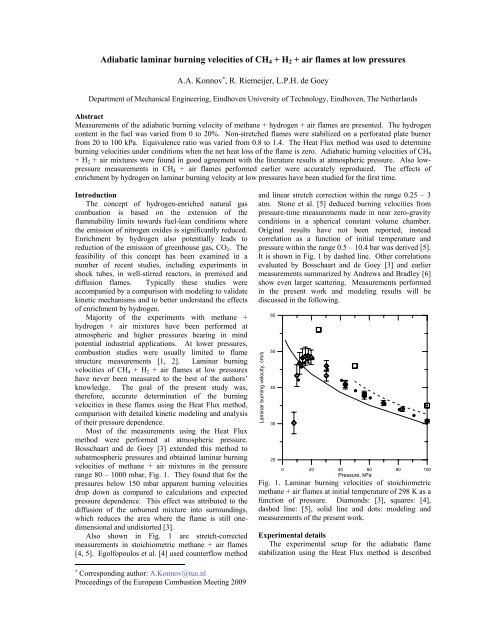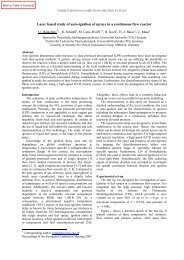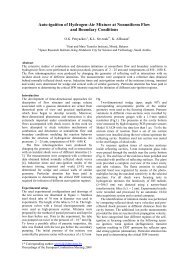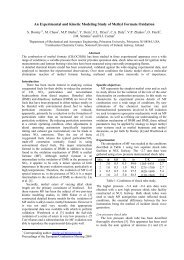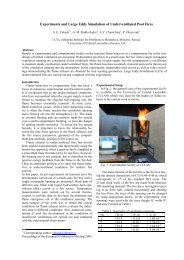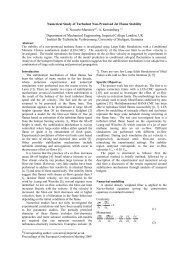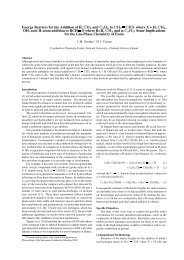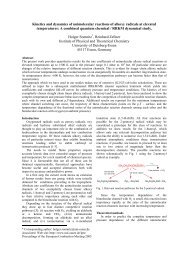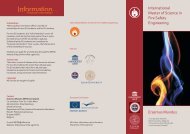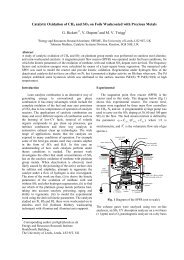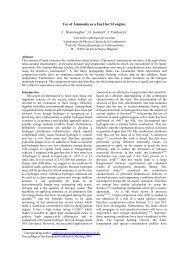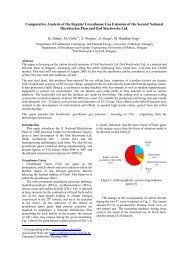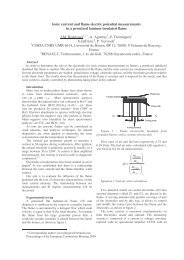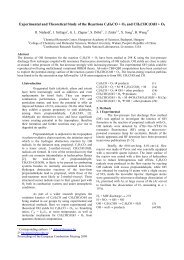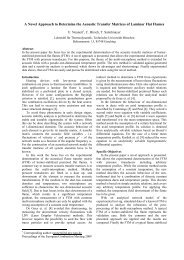Adiabatic laminar burning velocities of CH4 + H2 + air flames at low ...
Adiabatic laminar burning velocities of CH4 + H2 + air flames at low ...
Adiabatic laminar burning velocities of CH4 + H2 + air flames at low ...
You also want an ePaper? Increase the reach of your titles
YUMPU automatically turns print PDFs into web optimized ePapers that Google loves.
<strong>Adiab<strong>at</strong>ic</strong> <strong>laminar</strong> <strong>burning</strong> <strong>velocities</strong> <strong>of</strong> <strong>CH4</strong> + <strong>H2</strong> + <strong>air</strong> <strong>flames</strong> <strong>at</strong> <strong>low</strong> pressures<br />
A.A. Konnov ∗ , R. Riemeijer, L.P.H. de Goey<br />
Department <strong>of</strong> Mechanical Engineering, Eindhoven University <strong>of</strong> Technology, Eindhoven, The Netherlands<br />
Abstract<br />
Measurements <strong>of</strong> the adiab<strong>at</strong>ic <strong>burning</strong> velocity <strong>of</strong> methane + hydrogen + <strong>air</strong> <strong>flames</strong> are presented. The hydrogen<br />
content in the fuel was varied from 0 to 20%. Non-stretched <strong>flames</strong> were stabilized on a perfor<strong>at</strong>ed pl<strong>at</strong>e burner<br />
from 20 to 100 kPa. Equivalence r<strong>at</strong>io was varied from 0.8 to 1.4. The He<strong>at</strong> Flux method was used to determine<br />
<strong>burning</strong> <strong>velocities</strong> under conditions when the net he<strong>at</strong> loss <strong>of</strong> the flame is zero. <strong>Adiab<strong>at</strong>ic</strong> <strong>burning</strong> <strong>velocities</strong> <strong>of</strong> <strong>CH4</strong><br />
+ <strong>H2</strong> + <strong>air</strong> mixtures were found in good agreement with the liter<strong>at</strong>ure results <strong>at</strong> <strong>at</strong>mospheric pressure. Also <strong>low</strong>pressure<br />
measurements in <strong>CH4</strong> + <strong>air</strong> <strong>flames</strong> performed earlier were accur<strong>at</strong>ely reproduced. The effects <strong>of</strong><br />
enrichment by hydrogen on <strong>laminar</strong> <strong>burning</strong> velocity <strong>at</strong> <strong>low</strong> pressures have been studied for the first time.<br />
Introduction<br />
The concept <strong>of</strong> hydrogen-enriched n<strong>at</strong>ural gas<br />
combustion is based on the extension <strong>of</strong> the<br />
flammability limits towards fuel-lean conditions where<br />
the emission <strong>of</strong> nitrogen oxides is significantly reduced.<br />
Enrichment by hydrogen also potentially leads to<br />
reduction <strong>of</strong> the emission <strong>of</strong> greenhouse gas, CO2. The<br />
feasibility <strong>of</strong> this concept has been examined in a<br />
number <strong>of</strong> recent studies, including experiments in<br />
shock tubes, in well-stirred reactors, in premixed and<br />
diffusion <strong>flames</strong>. Typically these studies were<br />
accompanied by a comparison with modeling to valid<strong>at</strong>e<br />
kinetic mechanisms and to better understand the effects<br />
<strong>of</strong> enrichment by hydrogen.<br />
Majority <strong>of</strong> the experiments with methane +<br />
hydrogen + <strong>air</strong> mixtures have been performed <strong>at</strong><br />
<strong>at</strong>mospheric and higher pressures bearing in mind<br />
potential industrial applic<strong>at</strong>ions. At <strong>low</strong>er pressures,<br />
combustion studies were usually limited to flame<br />
structure measurements [1, 2]. Laminar <strong>burning</strong><br />
<strong>velocities</strong> <strong>of</strong> <strong>CH4</strong> + <strong>H2</strong> + <strong>air</strong> <strong>flames</strong> <strong>at</strong> <strong>low</strong> pressures<br />
have never been measured to the best <strong>of</strong> the authors’<br />
knowledge. The goal <strong>of</strong> the present study was,<br />
therefore, accur<strong>at</strong>e determin<strong>at</strong>ion <strong>of</strong> the <strong>burning</strong><br />
<strong>velocities</strong> in these <strong>flames</strong> using the He<strong>at</strong> Flux method,<br />
comparison with detailed kinetic modeling and analysis<br />
<strong>of</strong> their pressure dependence.<br />
Most <strong>of</strong> the measurements using the He<strong>at</strong> Flux<br />
method were performed <strong>at</strong> <strong>at</strong>mospheric pressure.<br />
Bosschaart and de Goey [3] extended this method to<br />
sub<strong>at</strong>mospheric pressures and obtained <strong>laminar</strong> <strong>burning</strong><br />
<strong>velocities</strong> <strong>of</strong> methane + <strong>air</strong> mixtures in the pressure<br />
range 80 – 1000 mbar, Fig. 1. They found th<strong>at</strong> for the<br />
pressures be<strong>low</strong> 150 mbar apparent <strong>burning</strong> <strong>velocities</strong><br />
drop down as compared to calcul<strong>at</strong>ions and expected<br />
pressure dependence. This effect was <strong>at</strong>tributed to the<br />
diffusion <strong>of</strong> the unburned mixture into surroundings,<br />
which reduces the area where the flame is still onedimensional<br />
and undistorted [3].<br />
Also shown in Fig. 1 are stretch-corrected<br />
measurements in stoichiometric methane + <strong>air</strong> <strong>flames</strong><br />
[4, 5]. Egolfopoulos et al. [4] used counterf<strong>low</strong> method<br />
∗ Corresponding author: A.Konnov@tue.nl<br />
Proceedings <strong>of</strong> the European Combustion Meeting 2009<br />
and linear stretch correction within the range 0.25 – 3<br />
<strong>at</strong>m. Stone et al. [5] deduced <strong>burning</strong> <strong>velocities</strong> from<br />
pressure-time measurements made in near zero-gravity<br />
conditions in a spherical constant volume chamber.<br />
Original results have not been reported, instead<br />
correl<strong>at</strong>ion as a function <strong>of</strong> initial temper<strong>at</strong>ure and<br />
pressure within the range 0.5 – 10.4 bar was derived [5].<br />
It is shown in Fig. 1 by dashed line. Other correl<strong>at</strong>ions<br />
evalu<strong>at</strong>ed by Bosschaart and de Goey [3] and earlier<br />
measurements summarized by Andrews and Bradley [6]<br />
show even larger sc<strong>at</strong>tering. Measurements performed<br />
in the present work and modeling results will be<br />
discussed in the fol<strong>low</strong>ing.<br />
Laminar <strong>burning</strong> velocity, cm/s<br />
65<br />
55<br />
45<br />
35<br />
25<br />
0 20 40 60 80 100<br />
Pressure, kPa<br />
Fig. 1. Laminar <strong>burning</strong> <strong>velocities</strong> <strong>of</strong> stoichiometric<br />
methane + <strong>air</strong> <strong>flames</strong> <strong>at</strong> initial temper<strong>at</strong>ure <strong>of</strong> 298 K as a<br />
function <strong>of</strong> pressure. Diamonds: [3], squares: [4],<br />
dashed line: [5], solid line and dots: modeling and<br />
measurements <strong>of</strong> the present work.<br />
Experimental details<br />
The experimental setup for the adiab<strong>at</strong>ic flame<br />
stabiliz<strong>at</strong>ion using the He<strong>at</strong> Flux method is described
elsewhere [3], however, the most relevant details are<br />
repe<strong>at</strong>ed here. Due to modific<strong>at</strong>ion <strong>of</strong> some elements <strong>of</strong><br />
the setup and <strong>of</strong> the mixture prepar<strong>at</strong>ion procedure,<br />
valid<strong>at</strong>ing experiments are also outlined.<br />
Fig. 2. The burner used in the He<strong>at</strong> Flux method.<br />
Cross-section <strong>of</strong> the burner used in the He<strong>at</strong> Flux<br />
method is shown in Fig. 2. The burner pl<strong>at</strong>e perfor<strong>at</strong>ed<br />
with small holes is <strong>at</strong>tached to the burner outlet. Six<br />
thermocouples are soldered into the pl<strong>at</strong>e surface <strong>at</strong> the<br />
upstream side. The burner head has a he<strong>at</strong>ing jacked<br />
supplied with thermost<strong>at</strong>ic w<strong>at</strong>er to keep the<br />
temper<strong>at</strong>ure <strong>of</strong> the burner pl<strong>at</strong>e constant. During the<br />
experiments this temper<strong>at</strong>ure was fixed <strong>at</strong> 353 K. The<br />
plenum chamber has a separ<strong>at</strong>e cooling system supplied<br />
with w<strong>at</strong>er <strong>at</strong> a temper<strong>at</strong>ure <strong>of</strong> 298 K. The he<strong>at</strong>ing<br />
jacket keeps the burner pl<strong>at</strong>e edges <strong>at</strong> a certain<br />
temper<strong>at</strong>ure higher than the initial gas temper<strong>at</strong>ure, thus<br />
warming up the unburned gases f<strong>low</strong>ing through. If the<br />
flame is stabilized under sub-adiab<strong>at</strong>ic conditions, the<br />
gas velocity is <strong>low</strong>er than the adiab<strong>at</strong>ic flame <strong>burning</strong><br />
velocity and the sum <strong>of</strong> the he<strong>at</strong> loss and he<strong>at</strong> gain is<br />
higher than zero. Then the center <strong>of</strong> the burner pl<strong>at</strong>e is<br />
hotter than the he<strong>at</strong>ing jacket. If the unburned gas<br />
velocity is higher than the adiab<strong>at</strong>ic <strong>burning</strong> velocity<br />
(super-adiab<strong>at</strong>ic conditions), the net he<strong>at</strong> flux is <strong>low</strong>er<br />
than zero and the center <strong>of</strong> the burner pl<strong>at</strong>e is cooler<br />
than the he<strong>at</strong>ing jacket. By changing the f<strong>low</strong> r<strong>at</strong>e <strong>of</strong><br />
the gas mixture an appropri<strong>at</strong>e value <strong>of</strong> the gas velocity<br />
can be found to nullify the net he<strong>at</strong> flux. In this case the<br />
radial temper<strong>at</strong>ure distribution in the burner pl<strong>at</strong>e is<br />
uniform and equal to the temper<strong>at</strong>ure <strong>of</strong> the he<strong>at</strong>ing<br />
jacket. Experimentally the series <strong>of</strong> thermocouples<br />
<strong>at</strong>tached to the burner pl<strong>at</strong>e al<strong>low</strong> measuring the<br />
temper<strong>at</strong>ure distribution in it. The f<strong>low</strong> r<strong>at</strong>e <strong>at</strong> which<br />
the net he<strong>at</strong> flux is zero is shown to be an adiab<strong>at</strong>ic<br />
flame <strong>burning</strong> velocity [7]. A mixing panel was<br />
assembled for a gas supply from gas cylinders to the<br />
inlet <strong>of</strong> the burner’s plenum chamber. It consists <strong>of</strong> two<br />
ducts for the fuel (mixture) and <strong>air</strong>. Each duct<br />
connected to its own gas cylinder has a buffer vessel<br />
and a mass f<strong>low</strong> controller (MFC). Two thermost<strong>at</strong>s<br />
2<br />
provide the w<strong>at</strong>er supply to the he<strong>at</strong>ing and cooling<br />
jackets <strong>of</strong> the burner. Gas duct coils are immersed in<br />
the cold (298 K) thermost<strong>at</strong> to control the gas<br />
temper<strong>at</strong>ure before the MFCs.<br />
The install<strong>at</strong>ion for the He<strong>at</strong> Flux measurements <strong>at</strong><br />
sub<strong>at</strong>mospheric pressures was out <strong>of</strong> use for a long time.<br />
Due to replacement <strong>of</strong> some key elements, pump,<br />
thermocouples and MFCs, valid<strong>at</strong>ing experiments were<br />
performed to ensure repe<strong>at</strong>ability and accuracy <strong>of</strong> the<br />
measurements. Figure 3 shows <strong>laminar</strong> <strong>burning</strong><br />
<strong>velocities</strong> <strong>of</strong> <strong>CH4</strong> + <strong>air</strong> <strong>flames</strong> <strong>at</strong> <strong>at</strong>mospheric pressure<br />
and initial temper<strong>at</strong>ure <strong>of</strong> 298 K obtained on different<br />
He<strong>at</strong> Flux install<strong>at</strong>ions [8, 9, 10] and in the present<br />
work.<br />
Laminar <strong>burning</strong> velocity, cm/s<br />
40<br />
30<br />
20<br />
10<br />
0<br />
0.5 0.7 0.9 1.1 1.3 1.5 1.7<br />
Equivalence r<strong>at</strong>io<br />
Fig. 3. Laminar <strong>burning</strong> velocity <strong>of</strong> methane + <strong>air</strong><br />
<strong>flames</strong> <strong>at</strong> <strong>at</strong>mospheric pressure and initial temper<strong>at</strong>ure<br />
<strong>of</strong> 298 K. Diamonds: [8], squares: [9], stars: [10], solid<br />
line and dots: modeling and measurements <strong>of</strong> the<br />
present work.<br />
Previous measurements <strong>of</strong> the <strong>laminar</strong> <strong>burning</strong><br />
<strong>velocities</strong> <strong>of</strong> methane + hydrogen + <strong>air</strong> <strong>flames</strong> using the<br />
He<strong>at</strong> Flux method <strong>at</strong> <strong>at</strong>mospheric pressure have been<br />
performed by Coppens et al. [11, 12] and by Hermanns<br />
[9] and summarized by Hermanns et al. [13]. Coppens<br />
et al. [11, 12] used fuel mixtures delivered from the<br />
mixing plant, while Hermanns [9] produced fuel<br />
mixtures on the spot using separ<strong>at</strong>e MFCs for methane<br />
and hydrogen. Two approaches for the fuel mixture<br />
prepar<strong>at</strong>ion may cause some discrepancies as was noted<br />
before in the case <strong>of</strong> oxidizer prepar<strong>at</strong>ion [10]. In the<br />
present work methane and two mixtures containing 10<br />
and 20 vol. % <strong>of</strong> hydrogen in the fuel delivered from the<br />
mixing plant have been used. These compositions<br />
correspond to those studied by Hermanns [9] and, for<br />
the sake <strong>of</strong> further valid<strong>at</strong>ion, his d<strong>at</strong>a and present<br />
measurements <strong>at</strong> <strong>at</strong>mospheric pressure are confronted in<br />
Fig. 4. For the three fuels studied (Figs. 3 and 4) very<br />
good agreement with the liter<strong>at</strong>ure results is found.
Finally <strong>low</strong>-pressure measurements <strong>of</strong> Bosschaart and<br />
de Goey [3] in stoichiometric methane + <strong>air</strong> <strong>flames</strong> have<br />
been repe<strong>at</strong>ed with excellent reproducibility, see Fig. 1.<br />
Apparent <strong>burning</strong> <strong>velocities</strong> drop down <strong>at</strong> pressures<br />
be<strong>low</strong> about 20 kPa. Direct photographs <strong>of</strong><br />
stoichiometric methane + <strong>air</strong> <strong>flames</strong> presented in Fig. 5<br />
show th<strong>at</strong> the central fl<strong>at</strong> region <strong>of</strong> the flame rapidly<br />
shrinks with pressure hampering correct measurements<br />
<strong>at</strong> <strong>low</strong>er pressures on the burner <strong>of</strong> 30 mm in diameter.<br />
Therefore present experiments were confined to the<br />
range from 20 to 100 kPa.<br />
Laminar <strong>burning</strong> velocity, cm/s<br />
50<br />
40<br />
30<br />
20<br />
10<br />
0<br />
0.5 0.7 0.9 1.1 1.3 1.5 1.7<br />
Equivalence r<strong>at</strong>io<br />
Fig. 4. Laminar <strong>burning</strong> velocity <strong>of</strong> methane + hydrogen<br />
+ <strong>air</strong> <strong>flames</strong> <strong>at</strong> <strong>at</strong>mospheric pressure and initial<br />
temper<strong>at</strong>ure <strong>of</strong> 298 K. Squares: 10 % <strong>of</strong> <strong>H2</strong> in the fuel<br />
[9], diamonds: 20 % <strong>of</strong> <strong>H2</strong> in the fuel [9], solid lines and<br />
dots: modeling and measurements <strong>of</strong> the present work.<br />
Fig. 5. Direct photographs <strong>of</strong> stoichiometric methane +<br />
<strong>air</strong> <strong>flames</strong> <strong>at</strong> <strong>low</strong> pressures.<br />
An overall accuracy <strong>of</strong> the <strong>burning</strong> velocity<br />
measurements was estim<strong>at</strong>ed [3] to be better than ± 0.5<br />
cm/s (double standard devi<strong>at</strong>ion with 95 % confidence<br />
level) <strong>at</strong> 100 kPa increasing to ± 5 cm/s <strong>at</strong> 10 kPa. A<br />
procedure for estim<strong>at</strong>ion <strong>of</strong> errors in equivalence r<strong>at</strong>io<br />
was extended to binary fuel mixtures by Coppens <strong>at</strong> al.<br />
3<br />
[12]. The rel<strong>at</strong>ive accuracy <strong>of</strong> the equivalence r<strong>at</strong>io was<br />
found to be be<strong>low</strong> 1.5%.<br />
Modeling details<br />
A detailed C/H/N/O reaction mechanism for the<br />
combustion <strong>of</strong> small hydrocarbons was used for the<br />
modeling [14]. The current version <strong>of</strong> the mechanism<br />
(Release 0.5) consists <strong>of</strong> 1200 reactions among 127<br />
species. This mechanism has been valid<strong>at</strong>ed with<br />
experimental d<strong>at</strong>a available for oxid<strong>at</strong>ion, ignition, and<br />
flame structure <strong>of</strong> hydrogen, carbon monoxide,<br />
formaldehyde, methanol, methane, ethane, propane, and<br />
some <strong>of</strong> their mixtures, e.g. [10, 11, 12, 14]. In the<br />
present work the modeling was used mostly to compare<br />
experimentally observed trends with those predicted by<br />
the calcul<strong>at</strong>ions. No <strong>at</strong>tempts to modify the mechanism<br />
in order to improve its performance and agreement with<br />
the experiments were made.<br />
The CHEMKIN - II collection <strong>of</strong> codes [15-17],<br />
including transport properties [18] from Sandia N<strong>at</strong>ional<br />
Labor<strong>at</strong>ories, were used. Multi-component diffusion<br />
and thermal diffusion options were taken into account.<br />
Adaptive mesh parameters were GRAD = 0.05 and<br />
CURV = 0.5. Rel<strong>at</strong>ive and absolute error criteria were<br />
RTOL = 1.E-5 and ATOL = 1.E-9 respectively; total<br />
number <strong>of</strong> grid points was typically 350 – 400.<br />
Laminar <strong>burning</strong> velocity, cm/s<br />
60<br />
40<br />
20<br />
0<br />
0.7 0.9 1.1 1.3 1.5<br />
Equivalence r<strong>at</strong>io<br />
Fig. 6. Laminar <strong>burning</strong> velocity <strong>of</strong> methane +<br />
hydrogen + <strong>air</strong> <strong>flames</strong> (10 % <strong>of</strong> <strong>H2</strong> in the fuel) <strong>at</strong><br />
different pressures and initial temper<strong>at</strong>ure <strong>of</strong> 298 K.<br />
Symbols: experiment, lines: modeling. Crosses and<br />
solid line: 20 kPa, diamonds: 40 kPa, squares: 60 kPa,<br />
solid circles and dashed line: 80 kPa.<br />
Results and discussion<br />
New measurements in methane + hydrogen + <strong>air</strong><br />
<strong>flames</strong> <strong>at</strong> initial temper<strong>at</strong>ure <strong>of</strong> 298 K and <strong>low</strong> pressures<br />
are shown in Figs. 6 and 7 for 10 % and 20 % <strong>of</strong> <strong>H2</strong> in<br />
the fuel, respectively. Modeling results are shown for<br />
limiting series <strong>of</strong> 20 and 80 kPa to avoid too busy
graphs. The quality <strong>of</strong> agreement between the modeling<br />
and experiments is similar to the <strong>at</strong>mospheric d<strong>at</strong>a<br />
shown in Figs. 3 and 4 and demonstr<strong>at</strong>ed earlier in a<br />
wider range <strong>of</strong> hydrogen enrichment and dilution by<br />
nitrogen [11, 12]. Disagreement is most notable in<br />
around stoichiometric mixtures and slightly increases<br />
towards <strong>low</strong>er pressures, Fig. 1.<br />
Laminar <strong>burning</strong> velocity, cm/s<br />
80<br />
60<br />
40<br />
20<br />
0<br />
0.7 0.9 1.1 1.3 1.5<br />
Stoichiometric r<strong>at</strong>io<br />
Fig. 7. Laminar <strong>burning</strong> velocity <strong>of</strong> methane +<br />
hydrogen + <strong>air</strong> <strong>flames</strong> (20 % <strong>of</strong> <strong>H2</strong> in the fuel) <strong>at</strong><br />
different pressures and initial temper<strong>at</strong>ure <strong>of</strong> 298 K.<br />
Symbols: experiment, lines: modeling. Crosses and<br />
solid line: 20 kPa, diamonds: 40 kPa, squares: 60 kPa,<br />
solid circles and dashed line: 80 kPa.<br />
Laminar <strong>burning</strong> velocity, cm/s<br />
100<br />
9<br />
8<br />
7<br />
6<br />
5<br />
4<br />
3<br />
0 20 40 60 80 100<br />
Pressure, kPa<br />
Fig. 8. Laminar <strong>burning</strong> velocity <strong>of</strong> stoichiometric <strong>CH4</strong><br />
+ <strong>H2</strong> + <strong>air</strong> <strong>flames</strong> <strong>at</strong> initial temper<strong>at</strong>ure <strong>of</strong> 298 K as a<br />
function <strong>of</strong> pressure. Diamonds: pure methane; squares:<br />
10 % <strong>of</strong> hydrogen in the fuel; triangles: 20 % <strong>of</strong><br />
hydrogen in the fuel. Dashed bold lines: modeling,<br />
solid thin lines: exponential correl<strong>at</strong>ion (see text).<br />
4<br />
Figure 8 presents new measurements and modeling<br />
results in stoichiometric <strong>CH4</strong> + <strong>H2</strong> + <strong>air</strong> <strong>flames</strong>.<br />
Calcul<strong>at</strong>ed <strong>burning</strong> <strong>velocities</strong> shown as dashed bold<br />
lines in Fig. 8 are in s<strong>at</strong>isfactory agreement with the<br />
experiments. Figure 8 reveals two remarkable fe<strong>at</strong>ures:<br />
• Although diffusion properties <strong>of</strong> the fuel<br />
mixtures are different, the measured <strong>burning</strong> <strong>velocities</strong><br />
show no signs <strong>of</strong> drop down when the pressure<br />
approaches 20 kPa (cf. Fig. 1);<br />
• Experimental d<strong>at</strong>a show almost linear pressure<br />
dependences (solid thin lines) on a semi-logarithmic<br />
plot, while the modeling does not.<br />
These two fe<strong>at</strong>ures are discussed in the fol<strong>low</strong>ing.<br />
Diffusion <strong>at</strong> <strong>low</strong> pressures<br />
Bosschaart and de Goey [3] <strong>at</strong>tributed the effect <strong>of</strong><br />
drop down <strong>of</strong> the apparent <strong>burning</strong> velocity to diffusion<br />
<strong>of</strong> the unburned mixture (primarily fuel) into<br />
surroundings, which reduces the area where the flame is<br />
still one-dimensional and undistorted. At <strong>low</strong> pressures<br />
there are two possibilities, diffusion <strong>of</strong> the fuel to the<br />
surroundings, or diffusion <strong>of</strong> the burnt gases into the<br />
fresh mixture. Thus the composition <strong>of</strong> the gas present<br />
in the vacuum chamber may affect the <strong>laminar</strong> <strong>burning</strong><br />
velocity. Therefore the <strong>laminar</strong> <strong>burning</strong> <strong>velocities</strong> were<br />
measured while <strong>air</strong> was added to the chamber through<br />
an additional nozzle <strong>at</strong> the bottom <strong>of</strong> the chamber<br />
keeping the pressure constant. During the measurement<br />
the pressure was set to 21 kPa. Lower pressures were<br />
not accessible, since the pump could not cope with the<br />
increased “leakage”, the extra f<strong>low</strong>. The equivalence<br />
r<strong>at</strong>ios were set to 0.8, 1.0 and 1.2. Maximum additional<br />
<strong>air</strong> f<strong>low</strong> is comparable to the total f<strong>low</strong> <strong>of</strong> the fresh<br />
combustible mixture. The results <strong>of</strong> the measurements<br />
are presented in Fig. 9. It is clear th<strong>at</strong> when the<br />
concentr<strong>at</strong>ion <strong>of</strong> the <strong>air</strong> in the chamber is varied, there is<br />
no relevant effect on the <strong>laminar</strong> <strong>burning</strong> velocity.<br />
Fig. 9. The effect <strong>of</strong> the amount <strong>of</strong> the <strong>air</strong> added to the<br />
vacuum chamber on the apparent <strong>burning</strong> velocity.<br />
As it was stressed above, diffusion properties <strong>of</strong> the<br />
fuel mixtures are different, yet the measured <strong>burning</strong>
<strong>velocities</strong> show no signs <strong>of</strong> drop down when the<br />
pressure approaches 20 kPa (Fig. 8). One can conclude<br />
th<strong>at</strong> diffusion <strong>of</strong> the fuel and oxidizer in and out <strong>of</strong>f the<br />
fresh mixture is <strong>of</strong> minor importance. Besides <strong>of</strong> the<br />
diffusion <strong>of</strong> the mixture components, diffusion <strong>of</strong><br />
radicals should be considered. Modific<strong>at</strong>ion <strong>of</strong> the<br />
concentr<strong>at</strong>ion pr<strong>of</strong>iles <strong>of</strong> radicals rel<strong>at</strong>ed to the burner<br />
size <strong>at</strong> <strong>low</strong> pressures has been demonstr<strong>at</strong>ed in [19, 20].<br />
Rapid loss <strong>of</strong> radicals and, most probably, highly<br />
diffusive H <strong>at</strong>oms may effectively reduce <strong>burning</strong><br />
velocity in all <strong>flames</strong>, either lean or rich. One can also<br />
argue th<strong>at</strong> if the reason <strong>of</strong> the considered effect was a<br />
change in the fresh mixture composition, then <strong>at</strong> some<br />
conditions local <strong>burning</strong> velocity close to the burner<br />
edge could be higher than in the center. Yet, pressure<br />
decrease always leads to concave <strong>flames</strong>, Fig. 5. It is<br />
thus possible to conclude th<strong>at</strong> diffusion <strong>of</strong> radicals and<br />
<strong>at</strong>oms from the flame is the main reason <strong>of</strong> the dram<strong>at</strong>ic<br />
drop down <strong>of</strong> the apparent <strong>burning</strong> <strong>velocities</strong> <strong>at</strong> the<br />
pressures be<strong>low</strong> 20 kPa (Fig. 1).<br />
Pressure dependence<br />
Power-law pressure dependences were typically<br />
observed <strong>at</strong> pressures above <strong>at</strong>mospheric pressure:<br />
SL = SL0 * (P/P0) α<br />
where SL0 is the <strong>burning</strong> velocity <strong>at</strong> reference conditions<br />
(usually <strong>at</strong> 1 <strong>at</strong>m), and P0 is the reference pressure. To<br />
analyze apparent pressure dependence <strong>at</strong> <strong>low</strong> pressures<br />
measured <strong>burning</strong> <strong>velocities</strong> <strong>of</strong> stoichiometric methane<br />
+ <strong>air</strong> <strong>flames</strong> are shown in Fig. 10 on a log-log scale.<br />
Laminar <strong>burning</strong> velocity, cm/s<br />
100<br />
9<br />
8<br />
7<br />
6<br />
5<br />
4<br />
3<br />
10 100<br />
Pressure, kPa<br />
Fig. 10. Laminar <strong>burning</strong> <strong>velocities</strong> <strong>of</strong> stoichiometric<br />
methane + <strong>air</strong> <strong>flames</strong> <strong>at</strong> initial temper<strong>at</strong>ure <strong>of</strong> 298 K as a<br />
function <strong>of</strong> pressure. Bold line and diamonds: modeling<br />
and measurements <strong>of</strong> the present work. Thin line:<br />
exponential approxim<strong>at</strong>ion (see Fig. 8), dashed line:<br />
correl<strong>at</strong>ion <strong>of</strong> Stone et al. [5]; dash-dot line: correl<strong>at</strong>ion<br />
<strong>of</strong> Ts<strong>at</strong>saronis [21].<br />
Andrews and Bradley [6] derived the correl<strong>at</strong>ion SL<br />
= 43 P -0.5 cm/s for pressures gre<strong>at</strong>er than 5 <strong>at</strong>m; Stone et<br />
5<br />
al. [5] proposed for stoichiometric methane + <strong>air</strong> <strong>flames</strong><br />
from 50 to 1040 kPa an empirical correl<strong>at</strong>ion (dashed<br />
line in Fig. 10) with the power exponent <strong>of</strong> -0.314.<br />
Ts<strong>at</strong>saronis [21] found th<strong>at</strong> predicted <strong>burning</strong> <strong>velocities</strong><br />
<strong>at</strong> pressures be<strong>low</strong> 60 kPa show a much <strong>low</strong>er pressure<br />
exponent <strong>of</strong> -0.12 (dash-dot line in Fig. 10), which<br />
differs significantly from the calcul<strong>at</strong>ed power exponent<br />
<strong>of</strong> -0.51 <strong>at</strong> pressures gre<strong>at</strong>er than 4 <strong>at</strong>m. At very <strong>low</strong><br />
pressures all these power-law pressure dependences<br />
<strong>at</strong>tain infinity, which has no physical sense. Neither<br />
experimental d<strong>at</strong>a nor detailed kinetic modelling shows<br />
this trend. Calcul<strong>at</strong>ed <strong>burning</strong> <strong>velocities</strong> (bold line in<br />
Fig. 10) tend to a limiting value and qualit<strong>at</strong>ively<br />
correspond to an empirical exponential approxim<strong>at</strong>ion<br />
(like the thin line in Fig. 10). These approxim<strong>at</strong>ions for<br />
stoichiometric mixtures (Fig. 8) are:<br />
SL = 57.9 exp(-0.495 * P) cm/s for <strong>CH4</strong> + <strong>air</strong>,<br />
SL = 61.8 exp(-0.447 * P) cm/s for 10 % <strong>of</strong> <strong>H2</strong> in the<br />
fuel, and<br />
SL = 65.6 exp(-0.429 * P) cm/s for 20 % <strong>of</strong> <strong>H2</strong> in the<br />
fuel. Obvious trends in the limiting <strong>burning</strong> <strong>velocities</strong><br />
<strong>at</strong> zero pressure and in the logarithmic sensitivities to<br />
the pressure call for further research, which is an<br />
objective <strong>of</strong> the authors.<br />
Conclusions<br />
Experimental measurements <strong>of</strong> the adiab<strong>at</strong>ic <strong>burning</strong><br />
velocity in methane + hydrogen + <strong>air</strong> <strong>flames</strong> using the<br />
He<strong>at</strong> Flux method are presented. The hydrogen content<br />
in the fuel was varied from 0 to 20%. Non-stretched<br />
<strong>flames</strong> were stabilized on a perfor<strong>at</strong>ed pl<strong>at</strong>e burner from<br />
20 to 100 kPa. Equivalence r<strong>at</strong>io was varied from 0.8 to<br />
1.4. <strong>Adiab<strong>at</strong>ic</strong> <strong>burning</strong> <strong>velocities</strong> <strong>of</strong> <strong>CH4</strong> + <strong>H2</strong> + <strong>air</strong><br />
mixtures were found in good agreement with the<br />
liter<strong>at</strong>ure results <strong>at</strong> <strong>at</strong>mospheric pressure. Also <strong>low</strong>pressure<br />
measurements in <strong>CH4</strong> + <strong>air</strong> <strong>flames</strong> performed<br />
earlier were accur<strong>at</strong>ely reproduced. Calcul<strong>at</strong>ed <strong>burning</strong><br />
<strong>velocities</strong> using the Konnov mechanism are in<br />
s<strong>at</strong>isfactory agreement with the experiments over entire<br />
range <strong>of</strong> conditions. Dram<strong>at</strong>ic drop down <strong>of</strong> the<br />
apparent <strong>burning</strong> <strong>velocities</strong> <strong>at</strong> the pressures be<strong>low</strong> 20<br />
kPa could, most probably, be <strong>at</strong>tributed to the diffusion<br />
<strong>of</strong> radicals and <strong>at</strong>oms from the flame. Pressure<br />
dependences <strong>of</strong> the <strong>burning</strong> <strong>velocities</strong> for the three fuels<br />
studied could be approxim<strong>at</strong>ed by empirical exponential<br />
correl<strong>at</strong>ions. Implement<strong>at</strong>ion <strong>of</strong> power-law pressure<br />
dependences <strong>at</strong> <strong>low</strong>er pressures should be discouraged.<br />
Acknowledgements<br />
This work was supported by the STW (Technology<br />
Found<strong>at</strong>ion, The Netherlands) within the Project NWE<br />
06911 ”Towards a sustainable hydrogen economy: the<br />
emission <strong>of</strong> NOx by the combustion <strong>of</strong> n<strong>at</strong>ural gas<br />
premixed with hydrogen”.<br />
References<br />
1. S. De Ferrieres, A. El Bakali, B. Lefort, M. Montero,<br />
J.F. Pauwels, Combust. Flame 154 (2008) 601-623.<br />
2. A.V. Sepman, V.M. van Essen, A.V. Mokhov, H.B.<br />
Levinsky, Int. J. Hydr. Energy 33 (2008) 5850-5857.
3. K.J. Bosschaart, L.P.H. de Goey, Combust. Sci.<br />
Technol., 176 (2004) 1537-1564.<br />
4. F.N. Egolfopoulos, P. Cho, C.K. Law, Combust.<br />
Flame, 76 (1989) 375-391.<br />
5. R. Stone, A. Clarke, P. Beckwith, Combust. Flame,<br />
114 (1998) 546-555.<br />
6. G.E. Andrews, D. Bradley, Combust. Flame, 19<br />
(1972) 275-288.<br />
7. A. van Maaren, D.S. Thung, L.P.H. de Goey,<br />
Combust. Sci. Technol., 96 (1994) 327-344.<br />
8. K.J. Bosschaart, L.P.H. de Goey, Combust. Flame,<br />
132 (2003) 170-180.<br />
9. R.T.E. Hermanns. Laminar Burning Velocities <strong>of</strong><br />
Methane-Hydrogen-Air Mixtures. PhD thesis, Technical<br />
University <strong>of</strong> Eindhoven, 2007. Available <strong>at</strong>:<br />
http://www.combustion.tue.nl.<br />
10. I.V. Dyakov, A.A. Konnov, J. de Ruyck, K.J.<br />
Bosschaart, E.C.M. Brock, L.P.H. de Goey, Combust.<br />
Sci. Technol., 172 (2001) 81-96.<br />
11. F.H.V. Coppens, J. De Ruyck, A.A. Konnov,<br />
Combust. Flame 149 (2007) 409-417.<br />
12. F.H.V. Coppens, J. De Ruyck, A.A. Konnov, Exp.<br />
Therm. Fluid Sci., 31 (2007) 437-444.<br />
13. R.T.E. Hermanns, A.A. Konnov, R.J.M. Bastiaans,<br />
L.P.H. de Goey, K. Lucka, H. Kohne, Experimental<br />
characteriz<strong>at</strong>ion <strong>of</strong> the effects <strong>of</strong> temper<strong>at</strong>ure and<br />
composition on <strong>laminar</strong> <strong>burning</strong> <strong>velocities</strong> <strong>of</strong> <strong>CH4</strong> + <strong>H2</strong><br />
+ O2 + N2 <strong>flames</strong>, submitted to Fuel.<br />
14. A.A. Konnov, Detailed reaction mechanism for<br />
small hydrocarbons combustion, Release 0.5, 2000.<br />
http://homepages.vub.ac.be/~akonnov/. Available as<br />
Supplementary Electronic M<strong>at</strong>erial to [11].<br />
15. R.J. Kee, F.M. Rupley, J.A. Miller, Sandia N<strong>at</strong>ional<br />
Labor<strong>at</strong>ories Report, SAND89-8009, 1990<br />
16. R.J. Kee, J.F. Grcar, M.D. Smooke, J.A. Miller,<br />
Sandia N<strong>at</strong>ional Labor<strong>at</strong>ories Report, SAND85-8240,<br />
1990<br />
17. A.E. Lutz, R.J. Kee, J.A. Miller, Sandia N<strong>at</strong>ional<br />
Labor<strong>at</strong>ories Report, SAND87-8248, 1990<br />
18. R.J. Kee, G. Dixon-Lewis, J. Warn<strong>at</strong>z, M.E. Coltrin,<br />
J.A. Miller, Sandia N<strong>at</strong>ional Labor<strong>at</strong>ories Report,<br />
SAND86-8246, 1990<br />
19. K. Kohse-Hoinghaus, P. Koczar, Th. Just, Proc.<br />
Combust. Institute, 21 (1986) 1719-1727.<br />
20. J.B. Jeffries, G.P. Smith, D.E. Heard, D.R. Crosley,<br />
Ber. Bunsenges. Phys. Chem., 96 (1992) 1410-1416.<br />
21. G. Ts<strong>at</strong>saronis, Combust. Flame, 33 (1978) 217-239.<br />
6


